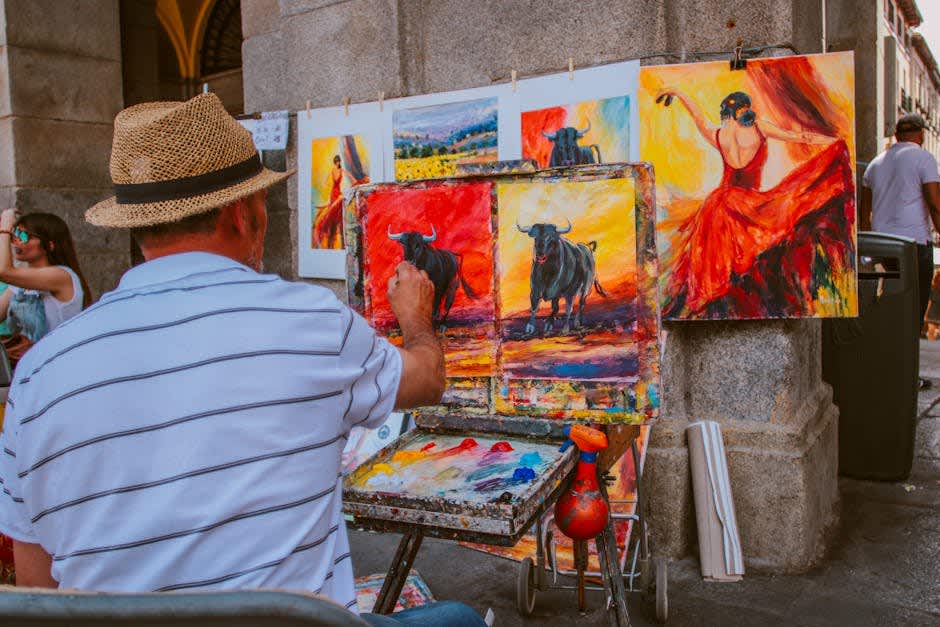


Selling art for beginners can be both an exciting and daunting endeavor. As an artist, the prospect of turning your passion into a viable business is a dream come true. However, many beginners stumble on common hurdles that can impede their success. In this blog post, we will explore the top five mistakes new artists make when selling their art and share effective strategies to avoid them. Whether you're learning how to sell art online or looking for beginner art selling tips, this guide will help you on your artistic journey.

When you first dip your toes into the exhilarating waters of selling art for beginners, it's easy to get swept up in the creative chaos, forgetting that your masterpieces need an audience—preferably one that isn't just your mom clicking 'like' on Facebook. Identifying your target audience is more than a smart strategy; it's the secret sauce that makes the difference between a hobby and a successful art business. Without knowing who your art resonates with, you might find yourself metaphorically playing jazz at a rock concert. Spoiler alert: it won't be well-received. 🎸
Understanding your audience is akin to knowing which style of art makes their hearts skip a beat. It’s about recognizing their tastes, their habits, and yes, even where they hang out online. Begin your detective work by tapping into the power of social media analytics. These tools aren’t just there to make you feel guilty for not posting enough—they're treasure troves of insights. You can discover everything from the age range of your followers to which posts they double-tap in the dead of night.
Here's a simple roadmap to help steer your efforts:
Once you've gathered this intel, tailor your marketing strategies like a bespoke suit. For instance, if your audience is mostly on Instagram, it's time to master the art of the perfect caption and learn when #artlovers are most active. Remember, “Knowing your audience is the first step in reaching them.”
The global art market is expected to reach $2.8 trillion by 2026. It’s a big, colorful pie—make sure you get your slice! [source]
In conclusion, selling art for beginners isn't just about putting your work out there; it's about putting it where it matters. So, wear your detective hat proud, do the research, and connect with those who are already waiting to fall in love with your unique style. After all, the right audience will turn your art from wallpaper to wall-worthy.
Ah, pricing—one of the most daunting hurdles when it comes to selling art for beginners. It's like trying to crack the enigmatic code to an art lover's wallet. Do it wrong, and you might end up either scaring potential buyers away or underselling your masterpieces. But fret not, dear artist! Understanding pricing is a journey worth embarking on to successfully navigate the art market.
First things first: context is key. To avoid falling into the trap of haphazard pricing, it's essential to delve into research. Take a cue from seasoned artists who share similar styles or mediums and analyze their pricing strategies. This doesn't mean copying their prices verbatim, but rather understanding the market dynamics. A study by ArtTactic revealed that transparency in pricing can increase buyer trust, leading to better sales outcomes.
So, how do you start? Here's a quick checklist to guide you through:
Once you have a baseline, don't shy away from experimenting with different price points. It’s akin to trying out different brush strokes—a little finesse might be needed. For instance, you may introduce a special collection at a promotional price to gauge audience response. The key is to be flexible yet strategic, adjusting prices based on feedback and demand.
“Pricing is not a science, but an art—an intuitive balancing act of perceived value and market reality.”
Remember, the price tag is not just about numbers; it’s a reflection of your brand. When you consistently set prices that represent your art's worth, you build credibility and trust with potential buyers. This becomes part of your identity as an artist—your pricing speaks volumes about your confidence in your work.
In essence, pricing is an art form of its own. By engaging in thoughtful research, considering tangible and intangible factors, and embracing a bit of experimentation, you can master the pricing game. And who knows, you might find that sweet spot where buyers are not just purchasing art, but investing in your vision.
 Image by <a href="https://pixabay.com/users/vika_glitter-6314823/?utm_source=link-attribution&utm_medium=referral&utm_campaign=image&utm_content=6638575">Victoria</a> from <a href="https://pixabay.com//?utm_source=link-attribution&utm_medium=referral&utm_campaign=image&utm_content=6638575">Pixabay</a>
Image by <a href="https://pixabay.com/users/vika_glitter-6314823/?utm_source=link-attribution&utm_medium=referral&utm_campaign=image&utm_content=6638575">Victoria</a> from <a href="https://pixabay.com//?utm_source=link-attribution&utm_medium=referral&utm_campaign=image&utm_content=6638575">Pixabay</a>
With the rise of digital platforms, simply listing your art on online marketplaces is like hanging a masterpiece in an empty gallery—it won't be seen. While platforms like Etsy, Saatchi Art, and Artfinder provide access to a global market and potential sales boosts, they aren't a magic solution. Many beginners believe that uploading their work is enough to attract buyers, but this "set it and forget it" approach limits visibility and results.
Each online marketplace caters to a specific audience: Etsy is known for unique, handcrafted items, making it ideal for one-of-a-kind art pieces; Saatchi Art appeals to collectors seeking high-quality original works; and Artfinder connects emerging artists with buyers looking for affordable art. But regardless of which platform you choose, success hinges on more than just creating a profile.
You need to actively drive traffic to these platforms. Promote your listings by leveraging your social media presence, newsletters, and even collaborations. Directing potential buyers to your marketplace page ensures that your art doesn't just sit unnoticed among thousands of others.
Given that you’ll be putting in effort to engage potential buyers and guide them to your work, it’s worth considering creating your own website. A personal website gives you full control over showcasing your art and building your brand while still linking to marketplace listings for easy purchasing.
Social media tools like Instagram and Facebook can play a huge role in your promotion strategy. Instagram has become a virtual gallery for many artists, allowing you to share your process, finished pieces, and stories to captivate a wider audience. As Picasso said, "Every artist was first an amateur," so approach these platforms with an open mind, post consistently, use relevant hashtags, and engage with your community to build connections.
The data backs this up: according to Hiscox, online art sales reached $4.8 billion in 2019 and have only grown since. This highlights the immense opportunity that lies in digital sales—but only if you actively put in the work to bring buyers to your art. So, while showcasing your art at local events has its place, don’t forget to upload and promote your work online to let it be seen by the vast digital world awaiting it.
"Every artist was first an amateur,"
So embrace these platforms with an experimental mindset. Post regularly, use relevant hashtags, and interact with followers to build a community around your art.
In fact, according to Hiscox, online art sales have been steadily increasing, revealing that the online art market reached $4.8 billion in 2019 alone. This statistic underscores the immense potential that lies in digital art sales. It's essential for beginner artists to leverage these platforms to their advantage. So, while it might be tempting to wrap your masterpiece in layers of bubble wrap for the local art fair, don't forget to click 'upload' and let your art venture into the vast, awaiting digital world.
First impressions linger like an indelible brushstroke on a canvas. When it comes to selling art for beginners, the presentation of your work can make or break a budding art career. It's akin to serving gourmet cuisine on a paper plate—sure, the dish might be delectable, but the lack of presentation could diminish its perceived value. This is a common oversight among artists who are just starting their journey into the art business. To truly captivate potential buyers, a professional presentation is essential, and here's how you can master it.
Let's begin with photography—your artwork's first digital handshake. According to a study published in Visual Studies, images are processed 60,000 times faster than text by the human brain, which means showcasing your art with high-quality images is non-negotiable. Avoid the rookie mistake of snapping pictures in poor lighting or with a cluttered backdrop. Instead, invest in good lighting and high-resolution cameras or even hire a professional photographer. This investment not only enhances your artwork's appeal but can exponentially increase engagement on digital platforms. When you increase the quality of your images, you'll see yourself increasing art sales!
Next, let's talk about the narrative behind your art. As Oscar Wilde once quipped,
"Every portrait that is painted with feeling is a portrait of the artist, not of the sitter."
Your artwork carries a piece of you, and a well-crafted description can convey this essence. Move beyond basic descriptions and weave in the story of inspiration, creation, and emotion that your piece embodies. This narrative can stimulate connection and interest, transforming a casual browser into a passionate buyer. Crafting such descriptions is an art in itself, blending storytelling with marketing to heighten the allure of your work.
Moreover, consider the complete brand experience. Just as a consistent and cohesive brand enhances a business's image, your art deserves the same attention. Consistent packaging—whether it's branded wrapping paper, custom thank-you notes, or elegant boxes—adds a layer of professionalism that buyers appreciate. It's akin to receiving a gift rather than a simple purchase, and it can significantly boost repeat patronage. A study highlighted by Smashing Magazine emphasizes that 90% of information transmitted to the brain is visual, reinforcing the importance of visual consistency in art branding.
Finally, polish your portfolio.
A captivating artist portfolio, either as a physical collection or online, serves as your visual resume. It should not only showcase your best works but also reflect your artistic journey and vision. Platforms like The Artist's Guide to Business can provide resources to help you create a professional and compelling portfolio. It doesn't matter how many art promotion techniques you use if you do not have the work to back it up. But remember, as you are building your portfolio, practice selling art for beginners so that you can become comfortable as soon as possible!
In the vibrant world of art sales, where emotions and aesthetics collide, every detail counts. By avoiding the pitfalls of unprofessional presentation, you're not just selling art—you're offering an experience, a connection, a piece of yourself. So, let your artistry shine in every facet of your presentation and watch as your art captivates and commands attention.
One of the most common oversights when selling art for beginners is the underestimation of networking and strategic promotion. Picture this: you're an orchestra of one, playing a symphony in an empty theater. It's a beautiful composition, but without an audience, what's the point? The art world thrives on connections and visibility, not unlike a social media influencer who never misses a chance to post about their latest travel escapade (because what is life if not a series of perfectly filtered experiences?).
Also, some of the best art selling advice I've ever received: do not forget the people you Already Know. Many artists, in the beginning of selling artwork, think they have to find collectors somewhere "out there." The truth is, the people "closest to home" will likely make great customers, and so you want to practice getting in front of them and selling to them before you worry about creating a big extended audience of strangers. Selling art on social media can be a great way to get started, especially when you use your personal account to sell to your friends and family.
By building relationships with fellow artists, galleries, and art communities, you unlock doors to new opportunities and potential collaborations. Take, for example, the renowned artist Banksy, who has managed to maintain anonymity while simultaneously engaging with a global audience. His secret? Networking in unconventional ways and utilizing digital platforms effectively.
So, how do you begin? Here are some art marketing strategies and beginner art selling tips you can employ:
Networking isn't just about selling; it's about creating a community. Even selling art for beginners who might think they don't have a community... you do!
As the artist Vincent van Gogh once said,
"I am seeking, I am striving, I am in it with all my heart."
Let your passion guide you, but don't forget the power of a solid network and strategic promotion. After all, in the art business for beginners, the combination of talent and visibility is your ticket to success.
In conclusion, selling art for beginners requires careful planning and strategic execution. By avoiding these common mistakes and embracing proven art sales strategies, you'll be better positioned to transform your passion into a profitable business. Remember, success in the art world is a journey, and with the right knowledge and tools, you're well on your way to achieving your artistic dreams.
 Image by <a href="https://pixabay.com/users/pexels-2286921/?utm_source=link-attribution&utm_medium=referral&utm_campaign=image&utm_content=1868562">Pexels</a> from <a href="https://pixabay.com//?utm_source=link-attribution&utm_medium=referral&utm_campaign=image&utm_content=1868562">Pixabay</a>
Image by <a href="https://pixabay.com/users/pexels-2286921/?utm_source=link-attribution&utm_medium=referral&utm_campaign=image&utm_content=1868562">Pexels</a> from <a href="https://pixabay.com//?utm_source=link-attribution&utm_medium=referral&utm_campaign=image&utm_content=1868562">Pixabay</a>



© 2024 The Artist's Guide to Business. All rights reserved.
Privacy Policy
Terms of Service
Cookies Settings
